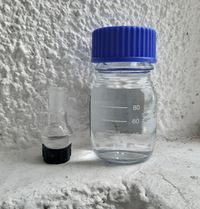Acetyl chloride

| |
| Names | |
|---|---|
| IUPAC name
Acetyl chloride
| |
| Preferred IUPAC name
Acetyl chloride | |
| Systematic IUPAC name
Ethanoyl chloride | |
| Other names
Acetic acid chloride
Acetic chloride | |
| Properties | |
| CH3COCl | |
| Molar mass | 78.49 g/mol |
| Appearance | Colorless fuming liquid |
| Odor | Pungent sharp |
| Density | 1.104 g/cm3 |
| Melting point | −112 °C (−170 °F; 161 K) |
| Boiling point | 52 °C (126 °F; 325 K) |
| Reacts | |
| Solubility | Reacts with alcohols, aldehydes, amines Miscible with glacial acetic acid, acetone, benzene, chloroform, diethyl ether, petroleum ether |
| Vapor pressure | 287 mm Hg (25 °C) |
| Thermochemistry | |
| Hazards | |
| Safety data sheet | Sigma-Aldrich |
| Flash point | 4 °C |
| Related compounds | |
| Related compounds
|
Acetic acid Benzoyl chloride |
| Except where otherwise noted, data are given for materials in their standard state (at 25 °C [77 °F], 100 kPa). | |
| Infobox references | |
Acetyl chloride is an organic compound, an acyl chloride derived from acetic acid. It has the formula CH3COCl.
Contents
Properties
Chemical
Acetyl chloride will react with alcohols to yield esters and hydrogen chloride:
- CH3COCl + CH2CH3OH → CH3-COO-CH2-CH3 + HCl
Physical
Acetyl chloride is a colorless fuming liquid, with a strong pungent sharp odor. It reacts with water and alcohols, but is soluble in many other organic solvents.
Availability
Acetyl chloride is sold by chemical suppliers. However, due to its hazards, it is difficult to acquire.
In some countries its sale is regulated as it can be used to make acetic anhydride, which is used for the manufacture of heroin.
Preparation
Acetyl chloride can be prepared through several ways.
The most OTC route to obtain acetyl chloride involves the reaction of acetonitrile and glacial acetic acid with HCl, at low temperatures, in a dry atmosphere. Chemplayer made a video, showing that acetyl chloride is produced, though for some reason the yield of this route is not great.[2]
- CH3COOH + CH3CN + 2 HCl → CH3COCl + CH3CONH2·HCl
It's possible lower temperatures and an excess of HCl might be needed to increase the yield.
An accessible route involves the reaction of acetic anhydride and HCl. Dried HCl gas is bubbled through acetic anhydride. The resulting product is fractionally distilled and the fraction with a close boiling point is collected and further purified. SM member Magpie was able to obtain crude acetyl chloride with a yield of 70% using this method.
Although if you need acetyl chloride for making the acetic anhydride, this route is not useful.
Reacting acetic acid with chlorinating agents, such as phosgene, phosphorus trichloride, phosphorus pentachloride, thionyl chloride, will also yield acetyl chloride. This is the most convenient route used in the lab, but these compounds are difficult to obtain and are sensitive to water, making this route expensive.
Heating a mixture of benzoyl chloride with sodium acetate will give acetyl chloride.
Reaction of chlorine with solid acetaldehyde at -196.1 °C in the presence of UV light produces acetyl chloride, as well as oligomeric acetaldehyde as major reaction products. [3]
Reacting chloromethane with carbon monoxide at 860 °C, in the presence of a catalyst, such as dry (NaPO3)6 or borax will give acetyl chloride.[4]
Another possible route involves reacting carbon tetrachloride with glacial acetic acid at 200 °C in the presence of several catalysts, such as MoO3-WO3, CuO-WO3, NiO-MoO3 or Al2O3-SiO2.[5]
One patent claims that one of the products from the hydrolysis of chloroform in the presence of iron(III) chloride, at temperatures between 150 - 160 °C is acetyl chloride. The process takes place at low pressure.[6]
Reaction of sulfuryl chloride with calcium acetate produces acetyl chloride.[7]
Projects
- Make acetic anhydride
- Make esters
Handling
Safety
Acetyl chloride reacts with moisture to release fumes of hydrogen chloride and acetic acid. These fumes are very corrosive. Proper protection should be worn when handling the compound.
Storage
Acetyl chloride should be stored in air-tight containers in cool and well ventilated places. Schlenk flasks can also be used to store the compound.
Disposal
Acetyl chloride can be neutralized by slowly and carefully dissolving it in a basic solution, then poured down the drain once fully neutralized.
References
- ↑ I.G. Farbenind.; Landolt-Boernstein E II 1651
- ↑ https://www.youtube.com/watch?v=aVYMV3aHuUU
- ↑ Mansueto, Edward S.; Wight, Charles A.; Journal of Physical Chemistry; vol. 96; nb. 3; (1992); p. 1502 - 1504
- ↑ US2062344
- ↑ US2700679
- ↑ US1870601
- ↑ DE151864